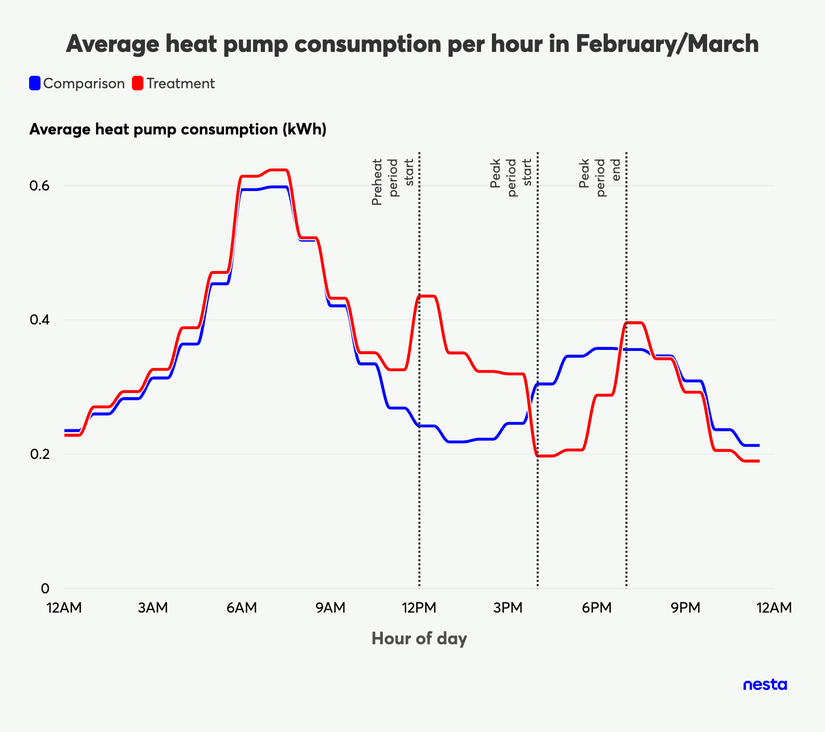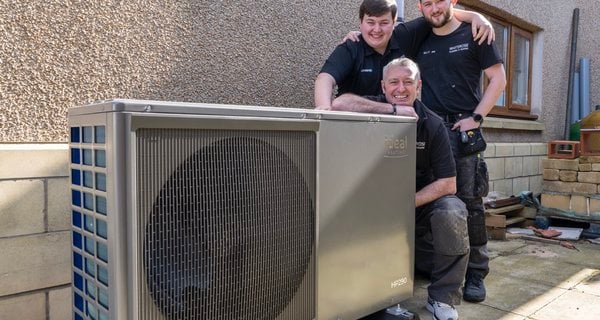Nesta partnered with OVO to explore how automated flexibility within a new type of electricity tariff could reduce heat pump running costs and support grid decarbonisation
Two of the largest barriers to heat pump adoption are considered to be the upfront cost of installation and their running costs. Promising routes to reducing running costs are the rebalancing of levies to reduce the spark gap, increasing heat pump coefficient of performance (COPs), and the use of innovative tariff types.
An additional route to reducing running costs could be using heat pumps flexibly, whereby their use corresponds to the price of electricity, avoiding times when electricity is most expensive. This trial explored the incorporation of automated flexibility into a novel tariff type, a type-of-use tariff offered by OVO called Heat Pump Plus. Users of Heat Pump Plus receive a flat rate tariff of 15p/kWh – but only on the electricity consumed by their heat pump. We shifted electrical demand away from peak periods by increasing setpoint temperatures by +1°C during a preheating period, then decreasing setpoint temperatures by -1°C during the peak period. The benefits of successfully developed automated flexibility are significant to both consumers and suppliers. Suppliers could shift the electricity that they sell to times when generation is cheaper and greener. In return, consumers are able to reduce their electrical bills by using a cheaper tariff.
Research aims of our trial
Our trial aimed to build upon previous research into heat pump flexibility by generating evidence on the following areas:
- Load shifting and value to consumers. Our primary objective was to reduce electrical consumption during peak periods by implementing optimised heating schedules.
- Customer comfort perception. We assessed whether participants found their homes comfortable and whether they had noticed any negative impacts as a result of our intervention.
- Impact on COP. We recorded whether our optimised heating timings would impact the COP of participants' heat pumps.
- Willingness for households to hand over control. We explored whether the introduction of automation to the Heat Pump Plus tariff would be acceptable to participants.
Our approach
In total, 58 OVO energy customers on the Heat Pump Plus tariff add-on took part in our trial. We altered the heating schedule of these participants every weekday between the 6th January 2025 and 1st April 2025. We recorded their internal temperatures and heat pump electrical consumption, and collected feedback on their experience via weekly surveys and two rounds of AI-powered interviews. We used a quasi-experimental approach, called matching, to enable us to assess the impact of altering the heating schedules of participants by comparing key outcomes with a comparison group of ~320 other OVO customers on Heat Pump Plus.
Our results
- We successfully managed to remotely automate our participants’ heat pumps, keeping internal temperatures within an acceptable range by preheating homes in advance of peak times.
- We found that, on average, 30% of each home’s space heating electrical demand was shifted away from the peak period between 4 pm and 7 pm.
- Participants reported high levels of satisfaction with their internal temperatures in the weekly surveys, with 88% of responses being satisfied, 7% being neutral, and only 5% dissatisfied.
- Overall, most households did not notice OVO’s control during the trial, with 60% of weekly survey responses saying that they had not noticed a difference in comfort.
- Our results were inconclusive about whether our intervention affected daily COP or total daily electrical consumption.
- Overall, households that took part in the trial had a positive experience and would feel comfortable allowing the continued automation of their heat pumps, although some expected additional incentives.

Average heat pump consumption per hour in February/March
Image Description
A line graph titled "Average heat pump consumption per hour in February/March" shows the average heat pump consumption in kilowatt-hours (kWh) over a 24-hour period.
The x-axis represents the "Hour of day," from 12 AM onwards. The y-axis represents the "Average heat pump consumption (kWh)," from 0 to 0.6.
There are two lines: a blue line for the "Comparison" group and a red line for the "Treatment" group. Both lines show similar consumption patterns from 12 AM to 12 PM, with a significant increase in the early morning hours, peaking around 6 AM to 7 AM.
Three vertical dashed lines mark key intervention periods. The first, labelled "Preheat period start," is at 12 PM. At this point, the red "Treatment" line rises sharply and remains higher than the blue "Comparison" line until 4 PM. The second dashed line, labelled "Peak period start," is at 4 PM. From this point until 7 PM, the red "Treatment" line drops significantly below the blue "Comparison" line. The third dashed line, labelled "Peak period end," is at 7 PM. After this point, the red line begins to rise, eventually aligning with the blue line toward the end of the day.
Conclusion
Our results support the growing evidence base that heat pumps can be used for flexibility, which could potentially be used to save money while maintaining householder satisfaction with the temperature of their homes. These findings mean that heat pump owners could make use of automated type-of-use tariffs such as Heat Pump Plus and potentially save up to £440 per year compared to a standard variable rate. This would also provide grid management services, reducing the need for expensive infrastructure upgrades, and helping to decarbonise our energy system as we reduce our reliance on carbon-intensive sources of electricity generation.











